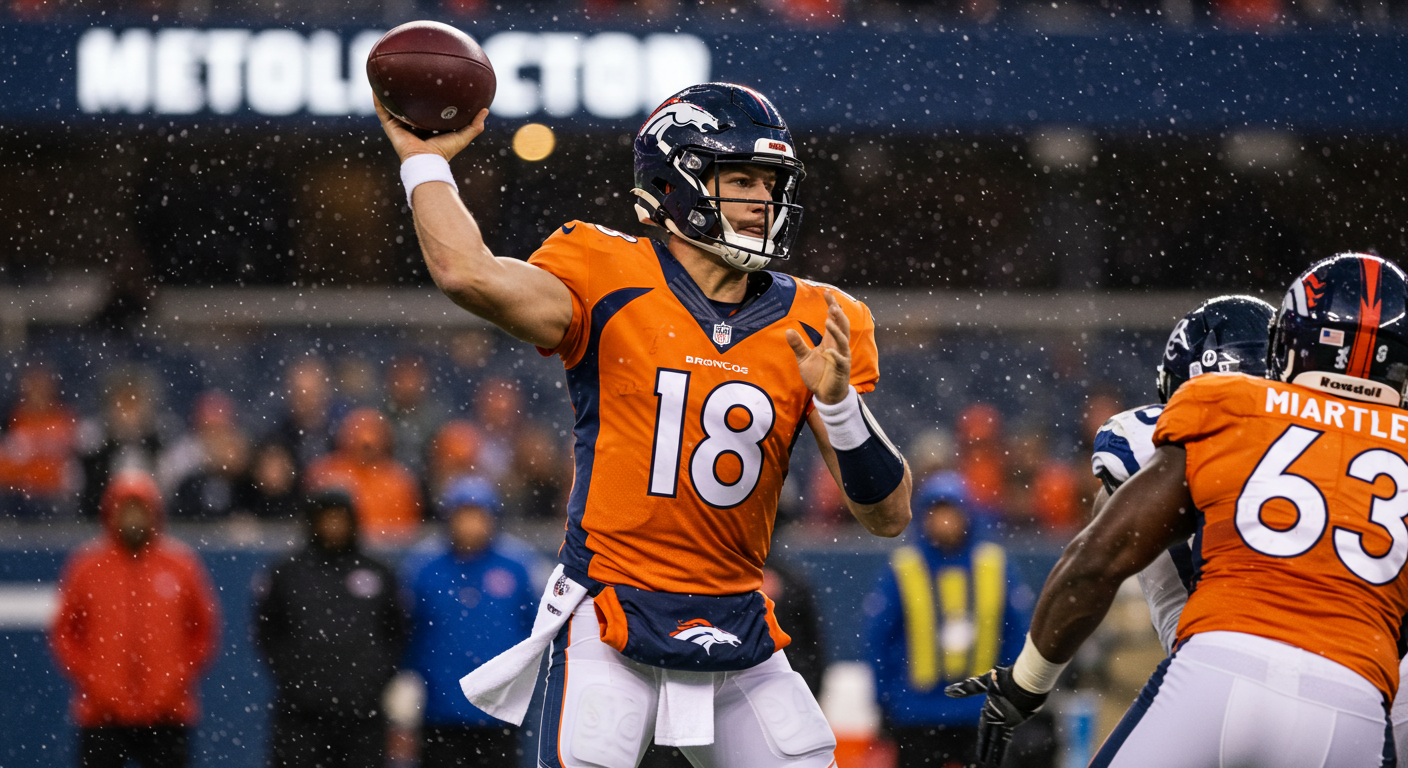

Denver Broncos vs New York Jets Match Player Stats (Sep 29, 2024)
The Denver Broncos defeated the New York Jets 10-9 at MetLife Stadium on September 29, 2024, in what became the NFL’s lowest-scoring game of the season. The defensive battle saw just one touchdown across 60 minutes of football, with both teams combining for 352 total yards in rain-soaked conditions.
Table of Contents
Game Overview and Conditions
MetLife Stadium hosted 82,243 fans for the Week 4 AFC matchup between Denver (1-2) and New York (2-1). Heavy rain throughout the contest created treacherous playing conditions, contributing to conservative play-calling and multiple scoring opportunities left on the field.
The game lasted 3 hours and 15 minutes, with the Jets controlling possession for 31:44 compared to Denver’s 28:16. Despite the time advantage, New York managed just three Greg Zuerlein field goals while Denver’s lone touchdown proved the difference.
Complete Team Statistics
| Category | Denver Broncos | New York Jets |
|---|---|---|
| Final Score | 10 | 9 |
| Total Yards | 123 | 229 |
| Passing Yards | 60 | 225 |
| Rushing Yards | 63 | 4 |
| First Downs | 10 | 18 |
| Third Down Efficiency | 0-7 (0%) | 1-7 (14.3%) |
| Time of Possession | 28:16 | 31:44 |
| Turnovers | 0 | 0 |
| Penalties | 1-15 | 0-0 |
| Red Zone Trips | 1-1 (100%) | 3-0 (0%) |
First Half: Jets Control Yields Just Six Points
New York dominated field position and possession through two quarters but settled for field goals on both red zone penetrations. The Jets’ inability to convert scoring opportunities would define their afternoon.
Quarter-by-Quarter Scoring
First Quarter
- No scoring
- Tyler Badie injury with 2:14 remaining
Second Quarter
- NYJ: Greg Zuerlein 23-yard FG (14:51)
- NYJ: Greg Zuerlein 35-yard FG (0:02)
Greg Zuerlein’s first field goal capped a 13-play, 70-yard drive that stalled at Denver’s 5-yard line. Three consecutive Aaron Rodgers incompletions forced the field goal attempt. The Jets’ second scoring drive covered 52 yards in the final 1:58, with Rodgers finding Mike Williams for 22 yards to set up Zuerlein’s 35-yarder at the half.
The Tyler Badie Injury
Denver running back Tyler Badie suffered a serious back injury late in the first quarter after catching a screen pass from Bo Nix. Jets linebacker Quincy Williams delivered the hit that jarred the ball loose and left Badie motionless on the field.
Medical personnel placed Badie on a backboard before carting him off after several minutes of on-field treatment. Coach Sean Payton offered no postgame update on Badie’s condition and wouldn’t confirm whether the running back traveled home with the team.
Michael Carter II recovered the fumble at Denver’s 34-yard line, but the Jets failed to capitalize on the short field.
Quarterback Performance Analysis
Statistical Comparison
| Quarterback | Comp-Att | Yards | TD-INT | Comp % | Rating | Y/A |
|---|---|---|---|---|---|---|
| Bo Nix (DEN) | 12-25 | 60 | 1-0 | 48.0% | 59.6 | 2.4 |
| Aaron Rodgers (NYJ) | 24-42 | 225 | 0-0 | 57.1% | 72.8 | 5.4 |
Bo Nix’s fourth career start produced his first touchdown pass but also his lowest yardage total. The rookie completed just 7 of 15 attempts for minus-7 yards in the first half before Sean Payton adjusted the game plan at halftime. Nix’s 60 passing yards marked the second-lowest total by a winning quarterback in 2024.
Aaron Rodgers generated 225 passing yards but couldn’t find the end zone against Denver’s third-ranked defense. The future Hall of Famer completed passes to eight different receivers, with Mike Williams (4-67) and Allen Lazard (5-58) leading the way. Rodgers took multiple hits throughout, including the game-sealing sack by P.J. Locke.
The Decisive Third Quarter
Denver’s offense finally broke through at the 3:08 mark of the third quarter. Bo Nix directed an 11-play, 87-yard touchdown drive that featured six running plays and a critical third-down conversion to Courtland Sutton.
The touchdown came on an 8-yard fade route to Sutton, who elevated over Jets cornerback D.J. Reed in the back right corner of the end zone. Nix placed the ball high where only his 6-foot-4 receiver could make the catch, with Sutton securing possession while dragging both feet inbounds.
Wil Lutz’s extra point gave Denver a 7-6 lead they wouldn’t relinquish.
Fourth Quarter: Trading Field Goals Before Late Drama
The game’s final 15 minutes produced the most compelling theater of the afternoon, with three lead changes and two missed field goals in the closing moments.
Fourth Quarter Timeline
13:34 – Greg Zuerlein 40-yard FG (NYJ leads 9-7)
- 10-play, 48-yard drive consuming 4:26
8:55 – Wil Lutz 47-yard FG (DEN leads 10-9)
- 9-play, 46-yard drive consuming 4:39
1:50 – P.J. Locke sacks Rodgers on 4th-and-10 from NYJ 35
- 10-yard loss, turnover on downs
1:31 – Wil Lutz misses 50-yard FG attempt wide left
- Denver’s three-and-out gives Jets final chance
0:51 – Greg Zuerlein misses 50-yard FG attempt wide right
- Jets’ desperation drive reaches DEN 32
The Allen Lazard Penalty
A critical moment occurred midway through the third quarter when Jets receiver Allen Lazard drew a 15-yard unsportsmanlike conduct penalty after a 13-yard reception. Officials flagged Lazard for making a gun-like gesture with both hands while signaling first down, violating the NFL’s prohibition on violent celebrations.
The penalty pushed the Jets from Denver’s 27-yard line back to the 42, effectively killing a promising drive that ended with a punt three plays later.
Individual Statistical Leaders
Rushing Performance
| Player | Team | Attempts | Yards | Average | Long | TD |
|---|---|---|---|---|---|---|
| Javonte Williams | DEN | 16 | 77 | 4.8 | 14 | 0 |
| Jaleel McLaughlin | DEN | 9 | 46 | 5.1 | 11 | 0 |
| Breece Hall | NYJ | 10 | 4 | 0.4 | 3 | 0 |
| Braelon Allen | NYJ | 2 | 0 | 0.0 | 1 | 0 |
Denver’s 123 rushing yards came primarily from Javonte Williams and Jaleel McLaughlin, who found success behind an offensive line that controlled the line of scrimmage after halftime. The Broncos averaged 4.5 yards per carry, establishing enough of a ground threat to set up play-action opportunities.
The Jets’ ground game never materialized. Breece Hall, who averaged 5.2 yards per carry in 2023 and ranked fifth in the NFL with 649 yards after catch, managed just 4 yards on 10 attempts. Denver’s defensive front, anchored by Zach Allen and D.J. Jones, consistently penetrated the backfield and disrupted New York’s rushing attempts at the point of attack.
Receiving Statistics
| Player | Team | Targets | Receptions | Yards | Average | TD |
|---|---|---|---|---|---|---|
| Mike Williams | NYJ | 11 | 4 | 67 | 16.8 | 0 |
| Allen Lazard | NYJ | 7 | 5 | 58 | 11.6 | 0 |
| Garrett Wilson | NYJ | 8 | 5 | 41 | 8.2 | 0 |
| Courtland Sutton | DEN | 2 | 1 | 8 | 8.0 | 1 |
| Javonte Williams | DEN | 1 | 1 | 4 | 4.0 | 0 |
| Breece Hall | NYJ | 2 | 1 | 9 | 9.0 | 0 |
Defensive Dominance: Statistical Breakdown
Defensive Leaders
| Player | Team | Position | Total Tackles | Solo | Sacks | TFL | QB Hits | PBU |
|---|---|---|---|---|---|---|---|---|
| C.J. Mosley | NYJ | LB | 9 | 8 | 0 | 0 | 0 | 0 |
| P.J. Locke | DEN | S | 7 | 7 | 1.0 | 1 | 1 | 0 |
| Zach Allen | DEN | DE | 5 | 4 | 0 | 2 | 2 | 0 |
| Quinnen Williams | NYJ | DT | 1 | 1 | 0 | 0 | 3 | 0 |
| Sauce Gardner | NYJ | CB | 3 | 3 | 0 | 0 | 0 | 1 |
| Pat Surtain II | DEN | CB | 2 | 2 | 0 | 0 | 0 | 1 |
Both defenses controlled the game from start to finish. Denver limited the Jets to 0.057 yards per play on the ground, the lowest figure allowed by any defense in 2024. The Jets countered by holding Denver to 2.2 yards per play through the air.
P.J. Locke’s fourth-down sack of Aaron Rodgers stands as the game’s defining defensive play. With 1:50 remaining and the Jets facing 4th-and-10 from their own 35, Locke beat right guard Alijah Vera-Tucker on an inside stunt to drop Rodgers for a 10-yard loss.
Special Teams Impact
Field Goal Summary
| Kicker | Team | FG Made | FG Att | Long | XP | Points |
|---|---|---|---|---|---|---|
| Greg Zuerlein | NYJ | 3 | 4 | 40 | 0-0 | 9 |
| Wil Lutz | DEN | 1 | 2 | 47 | 1-1 | 4 |
Punting Battle
| Punter | Team | Punts | Yards | Average | Inside 20 | Long |
|---|---|---|---|---|---|---|
| Riley Dixon | DEN | 8 | 362 | 45.3 | 3 | 56 |
| Thomas Morstead | NYJ | 7 | 329 | 47.0 | 2 | 58 |
Field position proved critical in a game with 15 combined punts. Both teams started just three drives in opponent territory, emphasizing the importance of the punting game in difficult conditions.
Coaching Decisions and Strategy
Sean Payton’s halftime adjustments transformed Denver’s offense. After managing just 48 yards in the first half, the Broncos shifted to a run-heavy approach that produced 75 second-half yards. Payton called runs on 18 of 28 second-half plays, taking pressure off his rookie quarterback.
Robert Saleh’s defensive game plan succeeded in limiting Denver to 123 total yards, but his offense couldn’t capitalize. The Jets ran 70 plays to Denver’s 56 but averaged just 3.3 yards per play. New York’s three red zone trips without a touchdown extended their season-long struggles inside the 20-yard line.
Red Zone Efficiency
Denver Broncos: 1 trip, 1 touchdown (100%) New York Jets: 3 trips, 0 touchdowns (0%)
According to Sharp Football Analysis, teams converting less than 40% of red zone trips into touchdowns typically rank in the bottom third of scoring offense. The Jets’ 0-for-3 performance epitomized their season-long struggles in scoring position.
Historical Context and Implications
The 19 combined points marked the lowest-scoring NFL game since the Steelers defeated the Dolphins 13-3 in 2007. Pro Football Reference data shows Denver’s 123 total yards as the third-lowest by a winning team since 2010.
For Denver, the victory validated their defensive identity while raising questions about offensive sustainability. The Broncos improved to 2-2, with both wins coming on the road against playoff contenders from 2023.
The Jets fell to 2-2 despite controlling most statistical categories. Their inability to score touchdowns in the red zone dropped them to 28th in red zone efficiency through four weeks. Per Pro Football Focus analysis, New York’s offensive line allowed pressure on 38% of Rodgers’ dropbacks, contributing to the red zone failures.
Looking Ahead
The Broncos proved a defense-first approach could still win in today’s NFL, even with minimal offensive production. Their formula of ball control, field position, and opportunistic defense provided a blueprint for future success with a developing quarterback.
For comparison, check out our analysis of the Buffalo Bills vs New York Jets match player stats to see how the Jets’ offensive struggles continued against another AFC East opponent.
The Jets faced uncomfortable questions about their Super Bowl aspirations. Despite elite defensive play and Aaron Rodgers under center, offensive coordinator Nathaniel Hackett’s unit couldn’t score when it mattered most. Their upcoming schedule included five straight games against winning teams from 2023, making offensive improvement essential.
Those interested in Denver’s defensive evolution can read our breakdown of the Denver Broncos vs Seattle Seahawks match player stats from later in the season.
Frequently Asked Questions
What was the final score of the Denver Broncos vs New York Jets game?
Denver defeated New York 10-9 at MetLife Stadium on September 29, 2024.
How many passing yards did Bo Nix have against the Jets?
Bo Nix completed 12 of 25 passes for 60 yards and one touchdown, posting a 59.6 passer rating.
Who scored the only touchdown in the game?
Courtland Sutton caught an 8-yard touchdown pass from Bo Nix with 3:08 remaining in the third quarter.
How many rushing yards did the Jets have?
The Jets rushed for just 4 yards on 12 attempts, with Breece Hall gaining 4 yards on 10 carries.
What was the game-deciding play?
P.J. Locke sacked Aaron Rodgers on 4th-and-10 with 1:50 remaining, sealing Denver’s victory.
How did weather impact the game?
Heavy rain throughout created difficult playing conditions, contributing to 15 combined punts and conservative play-calling from both teams.
Final Analysis
The Denver Broncos vs New York Jets match player stats reveal a game won in the margins. Denver’s 10-9 victory showcased defensive excellence overcoming offensive limitations. The Broncos managed just 123 total yards yet emerged victorious through superior red zone efficiency, timely special teams execution, and one crucial defensive stop.
The statistics tell the story of two elite defenses and two offenses that couldn’t solve them. In an era of record-breaking passing numbers and 40-point explosions, this game served as a reminder that defense and field position still matter. The Denver Broncos vs New York Jets match player stats will be remembered as an anomaly in 2024’s offensive-minded NFL landscape.







